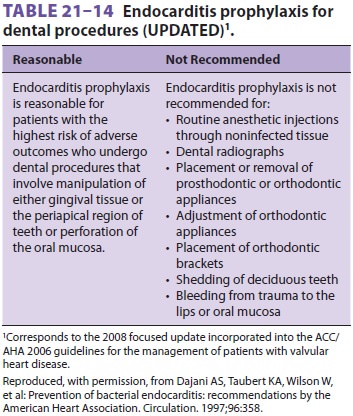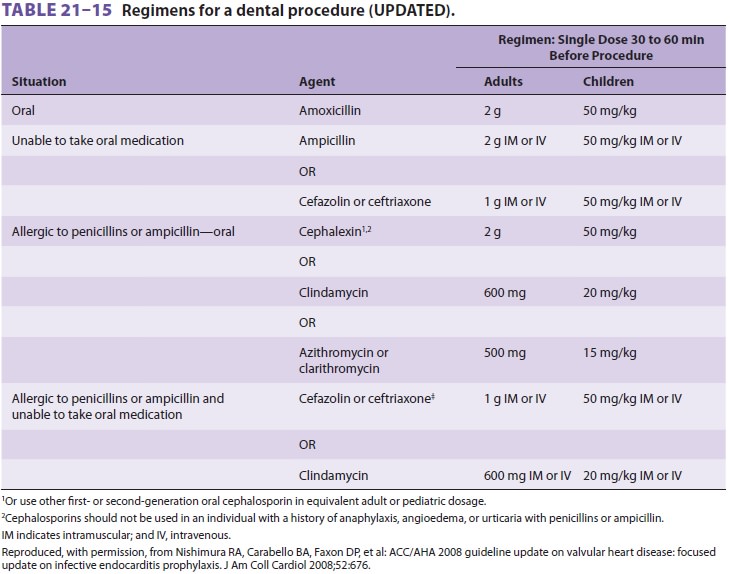Chapter: Clinical Anesthesiology: Anesthetic Management: Anesthesia for Patients with Cardiovascular Disease
Endocarditis Prophylaxis
ENDOCARDITIS PROPHYLAXIS
The ACC/AHA guidelines regarding
prophylac-tic antibiotic regimens in patients with prosthetic heart valves and
other structural heart abnormali-ties have dramatically changed in recent
years, decreasing the number of indications for antibiotic administration. The
risk of antibiotic administra-tion is often considered greater than the
potential for developing perioperative endocarditis. At pres-ent, the ACC/AHA
guidelines suggest the use of endocarditis prophylaxis in the highest risk
patients undergoing dental procedures involving gingival manipulation or
perforation of the oral mucosa (class IIa); see Tables 21–14 and 21–15.
Such con-ditions include:
·
Patients
with prosthetic cardiac valves or prosthetic heart materials
· Patients with a past history of endocarditis
·
Patients
with congenital heart diseasethat is either partially repaired or unrepaired
·
Patients
with congenital heart disease with residual defects following repair
·
Patients
with congenital heart disease within 6 months of a complete repair, whether
catheter-based or surgical
·
Cardiac
transplant patients with structurally abnormal valves
Class III recommendations indicate that
pro-phylaxis is not necessary for nondental procedures, including TEE and
esophagogastroduodenoscopy, except in the presence of an active infection.


Endocarditis is believed to occur in
areas of cardiac endothelial damage, where in cases of bacteremia, bacteria can
be deposited and multiply. Areas of increased myocardial blood flow velocity
lead to damaged endothelium, providing a template for bacterial adherence and
growth. Indeed, the lat-est ACC/AHA guidelines do not suggest prophylaxis for
genitourinary or gastrointestinal procedures; however, the AHA does note that
it is reasonable to administer antibiotics to prevent wound infection.
Moreover, they note that although prophylaxis is not suggested for respiratory
tract procedures, it is a reasonable strategy in high-risk patients in whom an
incision has been made in the respiratory tract (eg, in tonsillectomy).
In spite of these much reduced
indications, the ACC/AHA notes that many patients and phy-sicians expect the
administration of endocarditisprophylaxis in patients with valvular heart
dis-ease, aortic coarctation, and hypertrophic car-diomyopathy. As always, the
risk of antibiotic administration must be considered in offering prophylaxis to
patients outside of the ACC/AHA high-risk category. Guidelines are ever
chang-ing, and although not considered to be “standard of care,” they are
increasingly present in medi-cal practice; furthermore, deviation from
guide-lines often requires explanation as being outside of “evidenced-based”
practice. Review of ACC/ AHA guidelines, which are now available online, are
recommended when high-risk patients are encountered.
Related Topics